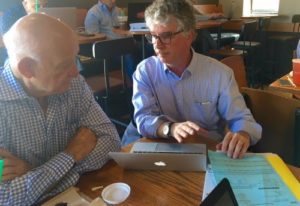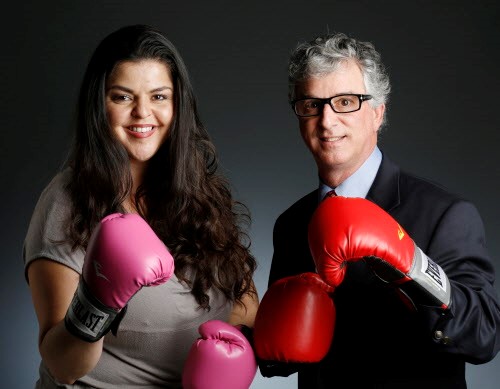You might not think of consumer columnists as narrative storytellers, or investigative reporters. But journalist Dave Lieber, “The Watchdog” for the Dallas Morning News, is a big fan of the creative-writing techniques of the New Journalism movement of the 1960s and says the biggest difference between him and other investigative reporters is “I do mine in a day and a half.”
Lieber’s twice-weekly consumer rights column tackles readers' real-world needs and questions. When a reader recently found out that his wife, who died in August, had been entered into a medical study without consent, he asked Lieber to investigate. Other readers want to know how to file property tax protests and about roofers who do bad work.
"Out of all the jobs I’ve had in journalism in 42 years, this one is the most reader-driven. It’s like I have a million assignment editors."
His writing goes far beyond what you might expect a columnist to do. With his assistant and partner, journalist Marina Trahan, each column involves carefully researched investigations, interviews and a narrative. Lieber is a columnist, but he employs investigative techniques and is a believer in the old saying “GOYA KOD.” Get off your ass, knock on doors. He says, “I use the techniques of the New Journalism movement: scene by scene construction, dialogue in full, a strong point of view and the use of status details. In every story, I’ve always tried to include those elements to show, not tell.”
And he isn’t afraid of upsetting powerful people: He was once reprimanded by the CEO of AT&T himself after he launched a #shameATT Twitter campaign because of readers’ complaints about the company.
I spoke to Lieber recently to discuss how his columns come together, the impact of reader input in his work and the importance of humor and storytelling in column writing. The conversation has been slightly edited for clarity.

What drew you to watchdog journalism?
For me, it was career survival. I was a Metro columnist for 12 years at the Fort Worth Star-Telegram. That was around the time blogging became really popular, around 2005. Opinion columnists were a dime a dozen. The editor at the Star-Telegram back then, Jim Witt, asked me if I wanted to switch over and become the watchdog character, because there was always going to be room for investigative work, whereas there might not be as much need for opinion writing. I switched gears at the right moment. I realized there was a reason why there were only about five or six watchdog journalists in America. It’s because the job is so damn hard. [It’s a lot] to be able to handle all the information that’s coming in, make all the deadlines, be in touch with all contacts and do the research on every story.
You get a lot of calls and emails from readers. How does that influence your column, and what role does the reader have on your writing?
Out of all the jobs I’ve had in journalism in 42 years, this one is the most reader-driven. It’s like I have a million assignment editors. Every day, I get a steady stream of emails. It’s been going on since I’ve been the Watchdog, for 12 years. I hear from people constantly, morning noon and night, seven days a week, 12 months a year. It’s amazing. The way it goes is, I write something [and two years later] it happens to them. They’ll Google it and contact me and go, “Hey, what you wrote about two years ago just happened to me yesterday.” A story based on some little scam that never gets fixed, I get to bring it back to life because someone came to me at the right moment. The story process feeds on itself.
What’s different about your work compared to other investigative reporters?
I do mine in a day and a half. I have two columns a week that I essentially have to do in four days. So I have a day and a half to research and a day to write each one. I work on every story with Marina [Trahan]. She’s an integral part of the operation, and she deserves as much of the credit as me, or blame. Investigative reporters typically have anywhere from a week to a month to a year. We don’t get to work like that.
"It goes back to the motto: No joy for the writer, no joy for the reader. No tears for the writer, no tears for the reader. No laughter for the writer, no laughter for the reader. What can I do to bring joys, laughter and tears into storytelling? I need to be emotionally moved by the idea to get others to be emotionally moved."
How do your columns come together? What goes into each investigation?
It goes back to the motto: No joy for the writer, no joy for the reader. No tears for the writer, no tears for the reader. No laughter for the writer, no laughter for the reader. What can I do to bring joys, laughter and tears into storytelling? I need to be emotionally moved by the idea to get others to be emotionally moved. I let the good stories rise to the top.
I filter through the dozens of emails we get each week. I pick what’s most interesting for people to read. It’s whatever feels right that week. Then I tell Marina what I’d like to do, and she gives me feedback and does a research packet for me, usually 30, 40, 50 pages on the subject. If we have to go out and interview someone, we usually go together. If not, I do the rest of the interviews myself. I use a filing system. I have hundreds of yellow file folders. When a file folder gets really thick with information and I’m moved emotionally, it’s time to launch it into the story stratosphere and turn it into a column. I have about 10 folders right now that are ready for the day-and-a-half process, but the file itself has letters, notes and articles about the subject. I write, and she edits. Her job is to debunk and find flaws and mistakes in whatever I’ve written. Then it goes to our editor, Dave Hiott.
You write in a very casual, often humorous tone. Why is this important in a column for consumers?
It’s important for any kind of column. I’ve been studying column writing for 40 years. I think all journalism has the potential to be great art and great storytelling. But for consumers specifically, it’s sometimes very frustrating and sad to be dealing with the modern-day BS of computerization, automation and customer call centers that are populated by idiots. So you want to lighten it up a little bit.
Can you talk more about writing creatively, since your columns often involve similar topics?
A [recent] column is about three consumer tools that you can use to make your life better. They’re really great tools, but the way I wrote it… the first two words are “Dear mom.” And the lede goes, I know you’re up in heaven, and I worry that you might not hear about what’s going on down here, so I hope you don’t mind if I fill you in. It’s a letter to my dead mother about what went on in the past year and asking her to fix these problems I can’t fix. Instead of doing a year-in-review, I wanted it to be a letter to my mom.
Q: What’s different about your work compared to other investigative reporters? A: I do mine in a day and a half.
What storytelling tips and investigative reporting techniques can you share with reporters interested in watchdog journalism?
I use the techniques of the New Journalism movement: scene by scene construction, dialogue in full, a strong point of view and the use of status details. In every story, I’ve always tried to include those elements to show, not tell. That’s always a challenge, because you’re not in the room when this stuff happens and you have to recreate it through interviews. A lot of stories don’t allow for it, but anytime it does and I can put a scene in, I jump at the chance. But for that to happen, you have to get out of the office, you have to go places and listen to people. You’re not going to get that in the office.
What do you want readers to take away from your column?
Very important information they can use that will change the way they live their lives and make their newspaper subscription totally valuable. I hear from people who say, “You helped me with the garage door company, you helped me with my property tax, you helped me with AT&T, which is the bane of my existence.” You remember that story about how the CEO of AT&T called me in and lectured me? That’s pretty much it. In one word, it would be value.
How has the column changed in 12 years?
The major change can be summed up in four words: less facts, more story. What I was doing when I started was interviewing people and then telling the reader, I interviewed all these people and here’s what they had to say. Here are all of the numbers and all of the facts. It read more like a straight news story than a column. I began to realize that I don’t have to tell the reader everything I learned, I only have to them what makes for a great story, and as long as I don’t leave out important information to keep it accurate and fair, I can do more story and less facts. Now I write more from the heart than from the head. The column is more emotional. But also, this is a character now that I’ve played for 12 years, the Watchdog. I’ve finally figured out who he is. He’s a guy who created Watchdog Nation [an offshoot of the column Lieber created to help people how to fight scams and be smart shoppers] because he made of all of these mistakes, and he’s learned to help other people how to not make mistakes.



